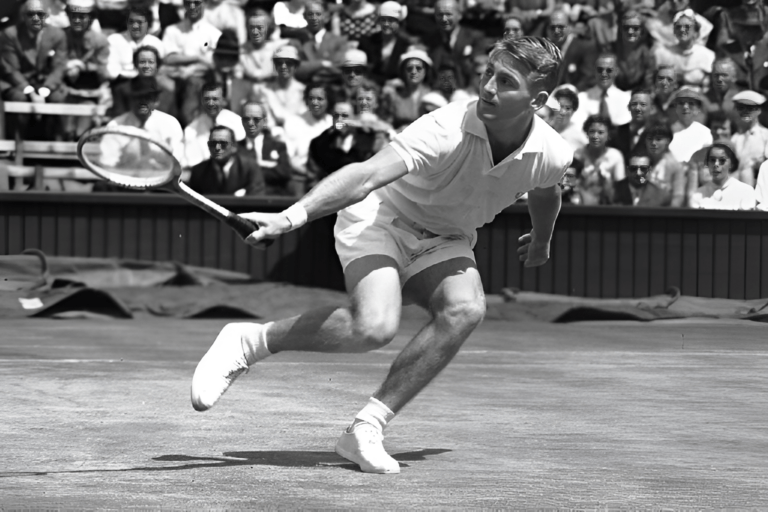Introduction
Born on November 23, 1934, in Sydney Australia, Lew Hoad was one of the greatest tennis players during the ’50s. Renowned for his powerful build, fiery demeanor and broad versatility in all courts, Hoad was a playboy magnet who went on to be co-number 1s with fellow countryman Ken Rosewall. Charismatic with explosive performances, he was one of the most loved by fans. Hoad’s career was a short-lived one but he still achieved multiple grand slam wins and some of the most memorable moments in tennis history which holds his name there.
Match Records And Career Stats
Combined with his attacking flair, Hoad’s dual-amateur-and-professional era career exemplifies the transition from an all-court goliath to an aggressive baseliner. While injuries cut short his playing career, Hoad’s success paid a dividend in the long run.
Career Overview:
- Total Singles Titles: 52
- Grand Slam Singles Titles: 4
- Doubles Titles: 7
- Professional Matches Won: 449
- Professional Matches Lost: 137
A versatile and hard-hitting competitor, Hoad generally overwhelmed opponents because of his strength and powerful game.
Takedowns in Table Format
| Year | Tournament | Round | Opponent | Result |
|---|---|---|---|---|
| 1956 | Wimbledon | Final | Ken Rosewall | Win (6-2, 4-6, 7-5, 6-4) |
| 1956 | Australian Open | Final | Ken Rosewall | Win (6-4, 3-6, 6-4, 7-5) |
| 1957 | Wimbledon | Final | Ashley Cooper | Win (6-2, 6-1, 6-2) |
| 1956 | French Open | Semifinal | Budge Patty | Win (6-3, 6-2, 6-3) |
| 1955 | US Open | Quarterfinal | Tony Trabert | Loss (3-6, 4-6, 6-3, 2-6) |
Hoad’s career was marked by his success in the most significant tournaments. His rivalry, in particular with Ken Rosewall, became the basis of the Australian tennis Golden Age.
Major Accomplishments and Top Moments
Lew Hoad won the highest-level competitions of his profession, four Grand Slam singles titles and seven Grand Slam pairs. When he was in his prime there were no other players germane to the game of basketball that had more power and grace when it came to playing on a court.
Grand Slam Singles Titles:
- Australian Open
- 1956 (Win over Ken Rosewall)
- Wimbledon
- 1956 (Win over Ken Rosewall)
- 1957 (Win over Ashley Cooper)
- French Open
- 1956 (Win over Sven Davidson)
Grand Slam Doubles Titles:
- Wimbledon
- 1953 (With Ken Rosewall)
- 1956 (With Ken Rosewall)
- Australian Open
- 1953 (With Ken Rosewall)
- French Open
- 1953 (With Ken Rosewall)
- US Open
- 1956 (With Ken Rosewall)
Other Major Achievements:
Davis Cup Wins
1953, 1955, 1956 (Australia)
Hoad may have had a much shorter tennis ‘lifespan’ than most but he made enough of an impact in both singles and doubles to be spoken of as one the best ever.
Family and Personal Life
In 1955, he married Jenny Staley, an Australian tennis player. With her love for boxing, the couple became known as one of Canada’s first true ”boxing couples” and over a number of years had two daughters; Beverley and then Fiona. Upon retiring from professional tennis, he and his wife moved to Spain and opened a tennis resort in Mijas near Malaga called the Lew Hoad Tennis Ranch. It was a waystation for aspiring and professional tennis players.
The thing about Hoad is his passionate affection for tennis transformed his life along with what became his enduring friendships (and sometimes rivalries) off the court — people like former Grand Slam champions Ken Rosewall and Rod Laver. Hoad coached and ran his resort and played tennis even after retiring.
Breaking News and Latest gossip
As a result of leukemia, he died from last 3 july 1994 at the age of only 59 years. However, despite his death, Hoad’s legacy lives on. He is still celebrated for his contributions to the game of tennis — particularly here in Australia as a trailblazer on so many fronts.
More recently, documentaries and articles have surfaced highlighting the importance of Hoad in what remains arguably the greatest era for men’s tennis. The exhibit is set to be a featured display at the International Tennis Hall of Fame beginning in 2024. He had an impact on the sport up until very recently, molding what we value in tennis today — athleticism and power.
Hoad is still in the conversation of the greatest tennis players ever as his name always comes up whenever this topic arises. He was also both Ken Rosewall’s favorite — and, for most of the rest of us churning through 60-odd years-worth of emotion to distill an essence from Pancho Segura says that when it comes down to those essential strata forming act one in a sport’s history there are fast approaches faster still. He has become a symbol for the best of Australian tennis and someone who played his part in helping to take the baton into the future.
Net Worth and Financial Snapshot
As of his death in 1994, Lew Hoad was worth about $1 million. He was such a skilled, young player that one of his primary sources of income came from being part owner at an incredibly profitable tennis resort in Spain. Hoad was well-off thanks to prize money in tennis at the time (not of course on a par with what they earn now), and business interests after quitting.
The Lew Hoad Tennis Ranch became a favorite place for tennis fans to go, providing an earned income in впосле career days of the champion. Investing in real estate and businesses related to tennis helped him make plenty of money for himself as well, making it so that he now has something safe stored away from his identity.
